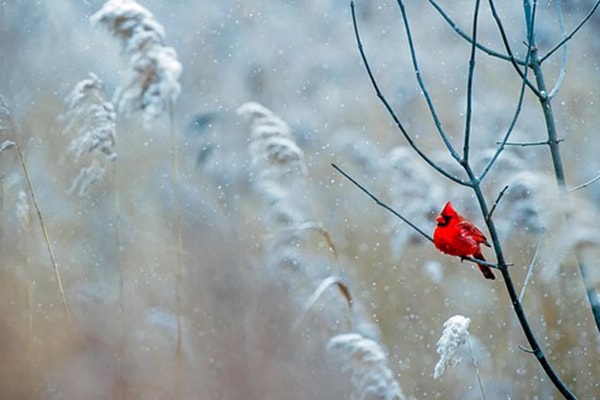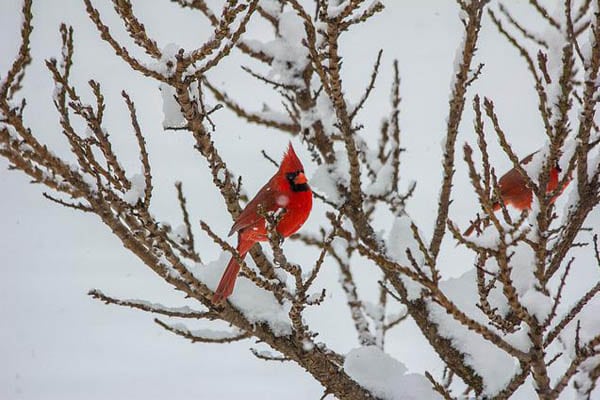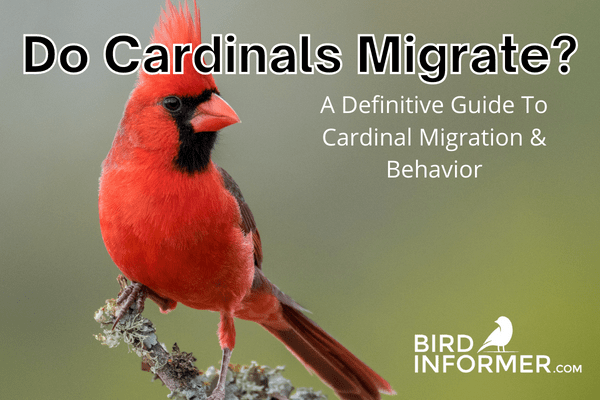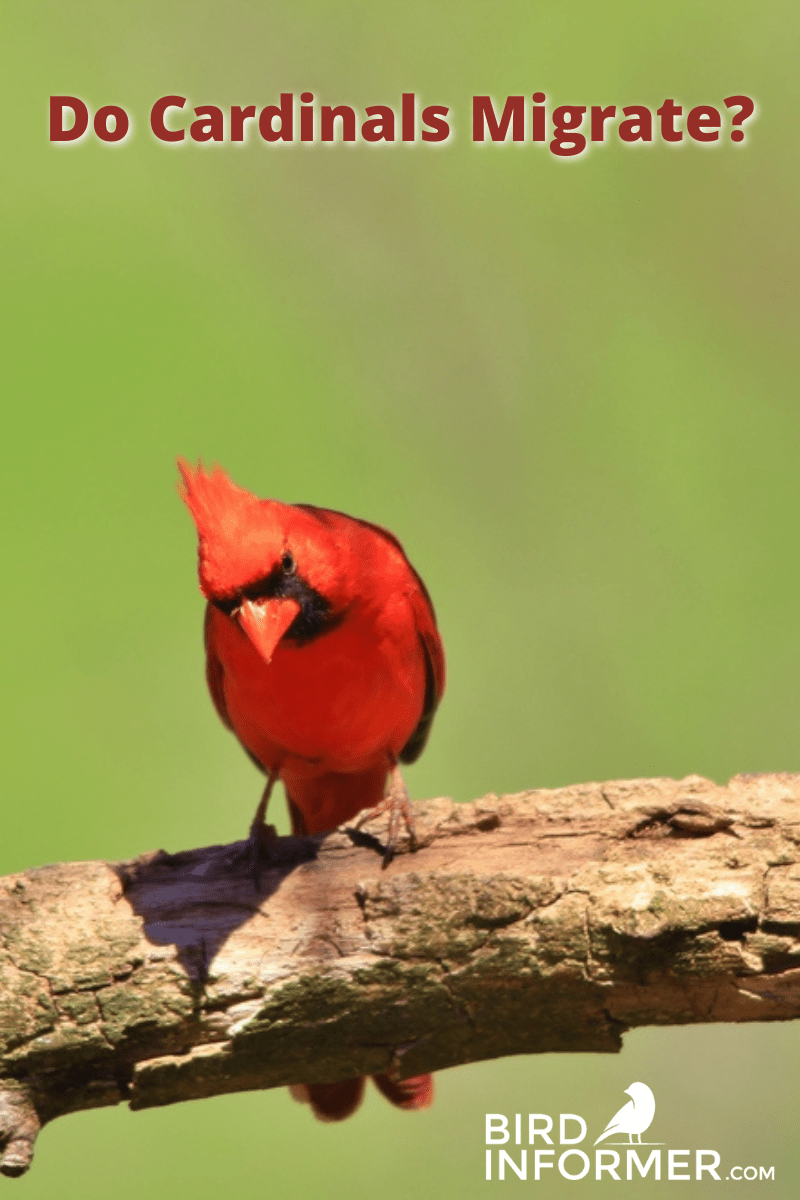Contents
- Do Cardinals Migrate? No, They Don’t!
- Survival Instinct: Why Do Cardinals Remain In Their Usual Territories During The Harsh Winter Months?
- Do Cardinals Migrate: Other Birds That Do Not Migrate During The Winter
- Hot Topic: How Do Cardinals Stay Warm During The Winter?
- Attractor Factor: How To Feed Cardinals During The Winter
- Living Arrangements: Where Do Cardinals Live During The Winter?
- Final Thoughts On An In-Depth Look At Cardinal Migrating Facts
Are you trying to find out if cardinals migrate for the winter? Where do they go? What do they eat? How do they survive? Find out if cardinals migrate during the winter and learn how they survive and thrive during this difficult time of year.
Cardinals don’t migrate. Their plumage remains beautifully bright all year and they do not molt either. It’s possible to see cardinals in your backyard during the snowy months if your home is in their territory. They continue to live in the eastern United States and in parts of Mexico year-round.

At the end of the day, cardinals are very resilient and it turns out that they don’t migrate because they can handle the cold weather wherever they are.
But how do they live? Many people wonder how they survive and thrive when it’s cold outside and food becomes scarce. To find out about this and more, please keep reading to discover the truth.
Do You Want To Attract Cardinals To Your Yard?
Check out our comprehensive product reviews of our top 10 favorite cardinal bird feeders. Click the button below to read this article.
Do Cardinals Migrate? No, They Don’t!
So many people find it hard to believe that cardinals remain in their regular territories and do not migrate during the winter. But it’s the truth and these resilient birds do not molt or present dog plumage at any time during the winter either.
If you look out your window and look in your backyard on a snowy winter day, you could see a breathtaking cardinal with four plumages. They look incredibly beautiful with snow on the bushes and trees as part of the backdrop because their red feathers really stand out.
Typically speaking, since cardinals do not migrate they will spend time in their usual territories all year-round. This is hard to believe, but they even remain in their territories on the Canadian border and the northernmost regions, which get incredibly cold and snowy during the winter.
On the other hand, more often than not, cardinals do not make the northernmost states their homes in the United States and they are very rarely found in the Canadian border. Yet, due to circumstances out of their control, and the early 1900s cardinals began extending their range further and are sometimes found in the North.
According to Birdfact.com, “Perhaps even more surprisingly, the Cardinal has not historically called the far northern states home. It has extended its range farther north since the early 1900s, likely due to increased food availability.”
Clearly, the cardinals were forced to range further north because of a lack of food during the wintertime. This is a valid reason to range further north, but it doesn’t constitute an official migration by any sense of the imagination.
Survival Instinct: Why Do Cardinals Remain In Their Usual Territories During The Harsh Winter Months?
Believe it or not, it’s a survival instinct that keeps cardinals from migrating during the cold and harsh winter months.
How so?
As mentioned earlier, Northern cardinals have their territories along a wide range throughout the United States. They can be found on the East Coast, the central plains, and in the south. It’s even possible to find cardinals within the southwestern parts of Mexico in the desert.
Cardinals often remain active during the winter, with one major exception. If the winter is too harsh, they will change their typical places for shelter. They will look for groves that contain low shrubs and dense vegetation to help protect against the freezing cold and biting winds. Otherwise, you can find cardinals in birds’ nests in trees and in forested areas.
Homeowners would love to provide shelter for beautiful bright red cardinals as often as possible, which is why many decide to provide birdhouses in their backyards.
Unfortunately, this isn’t going to work for the male Northern cardinal or the female, although you’ll find many beautiful birds in your birdhouse during the spring and summer months after other birds return.
Cardinals are not considered cavity nesters. They do not sleep or make their home within tree entry cavities and they typically avoid entering into birdhouses as well. It’s just not in their nature.
Do Cardinals Migrate: Other Birds That Do Not Migrate During The Winter
The Northern cardinal isn’t alone in its desire to stay put during the cold and snowy winter months. In fact, a number of other birds remain in their usual habitats once the temperatures drop and the freezing rain and snow begin to fall for days, weeks, or months at a time.
Other birds that remain in their habitats and do not migrate include:
- Anna’s Hummingbird
- Pileated Woodpecker
- Tufted Titmouse
- Common Raven
- Wild Turkey
- Great Horned Owl
- Northern Mockingbird
- Black-Capped Chickadee
- Blue Jay
- Northern Cardinal
For various reasons, each of these bird species does not migrate during the winter. They either live in relatively warm climates or they know how to survive and thrive during the cold and snowy winter months.
Hot Topic: How Do Cardinals Stay Warm During The Winter?
This fact is not very well known, but cardinals actually have the ability to control their body temperature, unlike other young birds, which allows them to remain warm during the winter.
Besides controlling their temperature, they also remained very active throughout their territories in the winter. They are constantly on the move as they fly from one territory to the next in search of food. This not only helps keep them at peak performance levels with high energy, but the constant movement helps them keep warm by keeping their heart pumping in their blood flowing freely.
How do male and female cardinals control their body temperature? They have two techniques that make body temperature control more than possible. They include:
- Fluffing their feathers
- Changing feather positions
Both of these activities make it possible to remain warm against the biting cold in a particularly vicious winter. By repositioning their feathers, they can protect their body by providing additional warmth. Fluffing their feathers achieves the same aim.
Attractor Factor: How To Feed Cardinals During The Winter
Instead of having a difficult time finding scarce food sources, the Northern cardinal has a diet that is made up of grasses, flowers, berries, seeds, grains, and nuts. It’s possible to find these foods and ample supplies in their normal northern territories without having to travel thousands of miles to find new food sources.
According to allaboutbirds.com, “Birds migrate to move from areas of low or decreasing resources to areas of high or increasing resources. The two primary resources being sought are food and nesting locations.”
Since migrating birds are looking for food and shelter, it isn’t a problem for Northern Cardinals to remain exactly where they are. As mentioned above, they have plenty of great food sources and they also have wonderful nesting opportunities right in their normal resting place.
Many homeowners continue to fill bird feeders for cardinals even in the colder regions during the winter months. This increases their food supply and makes it easier than ever for cardinals to remain healthy and strong during the cold and snowy seasons.
Living Arrangements: Where Do Cardinals Live During The Winter?

Do you love cardinals? Do you want to make sure they remain healthy and strong and well-fed during the winter? You can help these beautiful majestic birds stay safe and healthy by feeding them once the weather gets cold and other birds begin to migrate.
According to the website, This Is My Garden, “Not only is feeding cardinals in the wintertime a great way to add backyard activity and interest, but it can also play an important role in helping these beautiful birds survive through the long winter months.”
While feeding cardinals during the winter, you must provide the best food source, and the proper bird feeder, and it’s best to understand cardinal eating habits and select the right location for your bird feeders as well.
Choosing The Best Bird Feeder & Eating Habits
The right bird feeder for these birds is a flat feeder because they attract Northern cardinals. Since cardinals prefer to eat facing their food from the front, having a flat bird feeder with ample room for them to move is a great idea. They will sit on the feeder or perch, which means a platform feeder is typically the best option for cardinals.
Bird Feeder Location
To attract cardinals to your birdfeeder during the winter, you need to place it in the best possible location. Keeping your bird feeder protected under the shelter of a tree, near a shrub, or next to bushes is a great idea because that’s where these birds gravitate toward.
These sheltered areas also keep cardinals protected from other predators, including cats, squirrels, hawks, and other potential ground-dwelling animals.
Picking The Optimal Food Sources
Feeding birds like cardinals during the winter is important because their natural food sources are less available and they aren’t necessarily in plentiful supply. Giving cardinals exactly what they need is a great way to ensure their health and well-being during the winter.
The optimal dietary choices include safflower seeds and sunflower seeds. In particular, black oil sunflower seeds are a great fuel source because they contain lots of calories, high oil content, ample nutrition, and loads of energy that allow them to remain warm and healthy during the cold months.
Final Thoughts On An In-Depth Look At Cardinal Migrating Facts
By now, you definitely understand a lot more about cardinal migrating habits, or their lack thereof. These birds are literally designed to survive and thrive during the cold weather because they have the ability to regulate their body temperature which is amazing!
Today, I shared a great deal about cardinals and their migrating habits, how they survive during the winter, why they choose not to migrate, and other important facts.
A summary of the information shared above includes:
- Cardinals do not migrate. They control their own body temperature and know how to survive during harsh winters.
- They remain in their usual territories and forage for food and find shelter during the winter. They’ve learned to discover proper resting places and great food sources to scavenge when it’s cold and snowy.
- Northern cardinals remain in their typical territories during the winter. They will roam and scavenge the eastern United States, southern United States, and Central Plains. They take shelter in trees, shrubs, and bushes and avoid nesting in tree cavities or birdhouses.
- Cardinals stay warm during the winter by controlling their body temperature. They fluff their feathers and rearrange them to increase their body heat. They also travel throughout their territories which helps keep them warm when it’s cold outside.
Pay close attention to this valuable information because it may help you save a cardinal’s life during the winter. Nonetheless, cardinals do not migrate and it’s more than possible to see them perched in trees or on shrubs in your backyard on a bright snowy day.
If you have other information about cardinals and their migration habits, please feel free to share them in the comments. Thanks!


